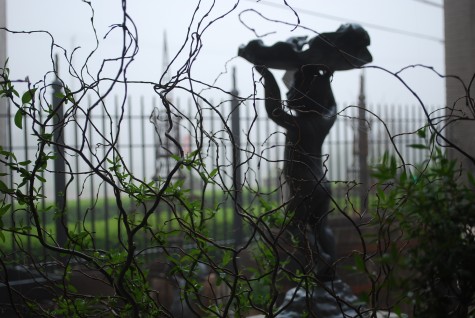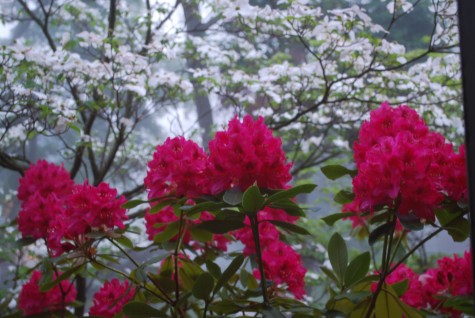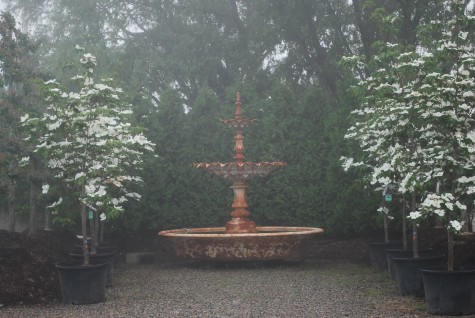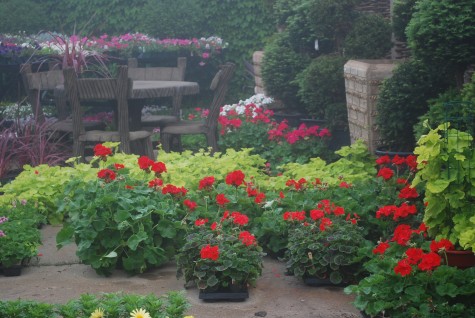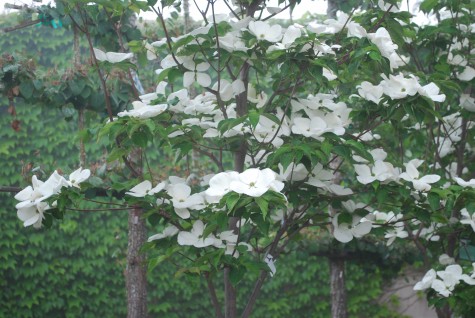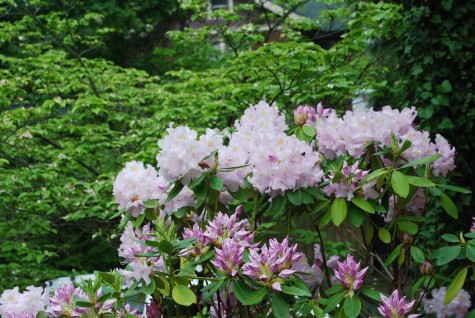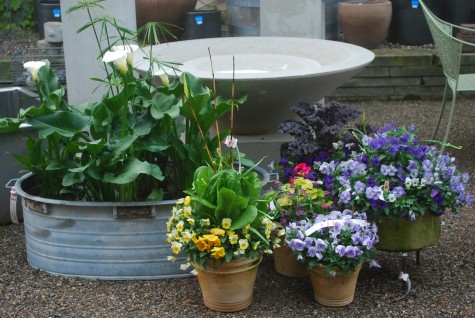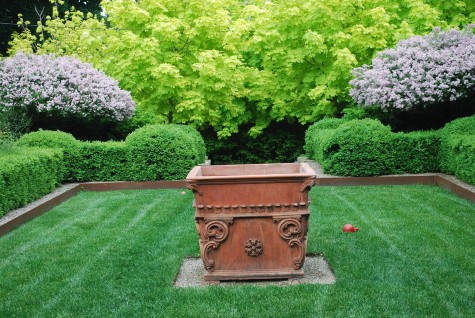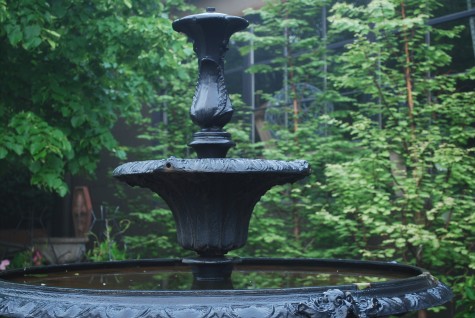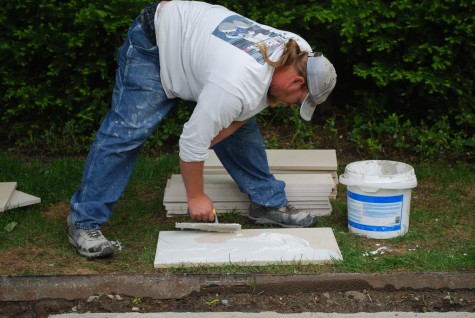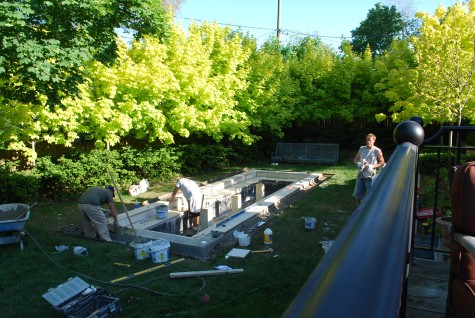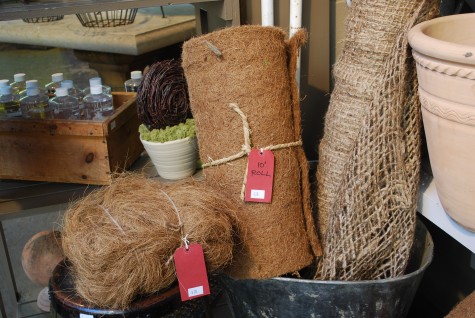Archives for May 2010
At A Glance: Rain and Fog
Loathe To Let Go
 May weather in Michigan is likely to be too cold, or too hot. As in, one extreme or the other, irregularly and unpredictably. Yesterday saw the temperature reach 80 degrees, for Pete’s sake. This untoward weather was attended by lots of phone calls from clients worrying that the summer was about to pass them by-could I plant their flowers right away? We do try to get everyone planted as quickly as possible-most people understand this, and are good natured about it. I tell clients the best thing I do for them is to isolate all the world noise, and concentrate on their place. I schedule plantings in an order suggested by the cold tolerance of the plants that need to be planted. I have some clients for whom I have been planting for 25 years-these clients are first up. Those clients aside, I change up plantings dates. If you were so kind as to be planted the second week of June last year, you get an earlier date this year. I grew up in and love a democracy-enough said. My crews are great. They unload the trucks, fill the pots, prep, plant topiaries and centerpieces-they do this rather than talk to me. They wait until we are done, to talk to me. I am crazy about them for this; they know how to set up and get ready-and leave me be to sort everything out. I myself like to plant late, in thoroughly warm soil. I am loathe to let go of the spring. My tulips at the shop have been so beautiful-for at least a month. But they are fading fast in the heat.
May weather in Michigan is likely to be too cold, or too hot. As in, one extreme or the other, irregularly and unpredictably. Yesterday saw the temperature reach 80 degrees, for Pete’s sake. This untoward weather was attended by lots of phone calls from clients worrying that the summer was about to pass them by-could I plant their flowers right away? We do try to get everyone planted as quickly as possible-most people understand this, and are good natured about it. I tell clients the best thing I do for them is to isolate all the world noise, and concentrate on their place. I schedule plantings in an order suggested by the cold tolerance of the plants that need to be planted. I have some clients for whom I have been planting for 25 years-these clients are first up. Those clients aside, I change up plantings dates. If you were so kind as to be planted the second week of June last year, you get an earlier date this year. I grew up in and love a democracy-enough said. My crews are great. They unload the trucks, fill the pots, prep, plant topiaries and centerpieces-they do this rather than talk to me. They wait until we are done, to talk to me. I am crazy about them for this; they know how to set up and get ready-and leave me be to sort everything out. I myself like to plant late, in thoroughly warm soil. I am loathe to let go of the spring. My tulips at the shop have been so beautiful-for at least a month. But they are fading fast in the heat.
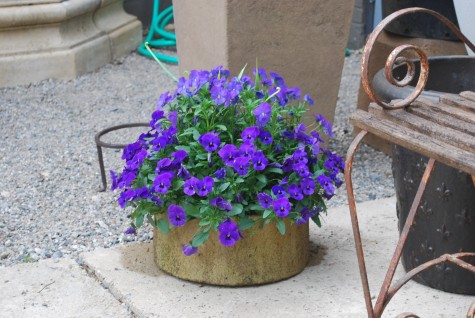 The spring pots are just beginning to hit their stride. Improvements in pansy and viola breeding has produced plants with great heat tolerance, and vigorous blooming. I am personally still stuck on the violas, and not yet focused on the summer season. I like the seasons-each one, in turn. The rhododendrons outside my office at home are breathtaking right now-pale pink blooms with a flush of yellow at the throat. Those impossibly long stamens-what an elegant flower graces the rhododendron. They speak to spring. I am listening.
The spring pots are just beginning to hit their stride. Improvements in pansy and viola breeding has produced plants with great heat tolerance, and vigorous blooming. I am personally still stuck on the violas, and not yet focused on the summer season. I like the seasons-each one, in turn. The rhododendrons outside my office at home are breathtaking right now-pale pink blooms with a flush of yellow at the throat. Those impossibly long stamens-what an elegant flower graces the rhododendron. They speak to spring. I am listening.
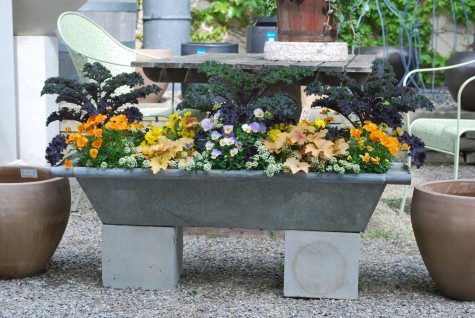 We planted up a number of galvanized troughs such as this one. Spring plants have distinctive color and shapes that are all their own. The kale will eventually bolt and go to seed when the hot weather arrives and stays. Peach melba heuchera and Citron alyssum make a fine spring pair. Lavender violas blushing peach-I know of no other flower that has coloration like this. For the moment, the spring season maturing has my attention.
We planted up a number of galvanized troughs such as this one. Spring plants have distinctive color and shapes that are all their own. The kale will eventually bolt and go to seed when the hot weather arrives and stays. Peach melba heuchera and Citron alyssum make a fine spring pair. Lavender violas blushing peach-I know of no other flower that has coloration like this. For the moment, the spring season maturing has my attention.
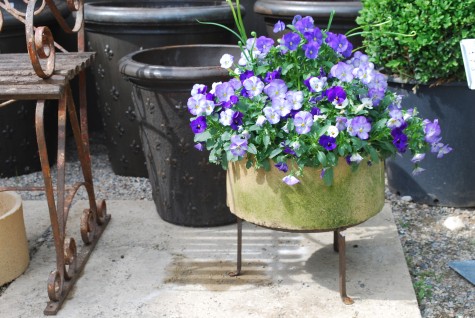 Spring white, lavender and purple-I am not ready to trade this in for a more summery look. I tour the pots and plantings at the shop every day, first thing. I tour my own garden, last thing, every day. It is not enough to see something briefly in a garden. I like every bit of it to settle around my bones, and take hold. Repeat trips in conjunction with my stubborn point of view; an unexpected change -this best describes my gardening life.
Spring white, lavender and purple-I am not ready to trade this in for a more summery look. I tour the pots and plantings at the shop every day, first thing. I tour my own garden, last thing, every day. It is not enough to see something briefly in a garden. I like every bit of it to settle around my bones, and take hold. Repeat trips in conjunction with my stubborn point of view; an unexpected change -this best describes my gardening life.
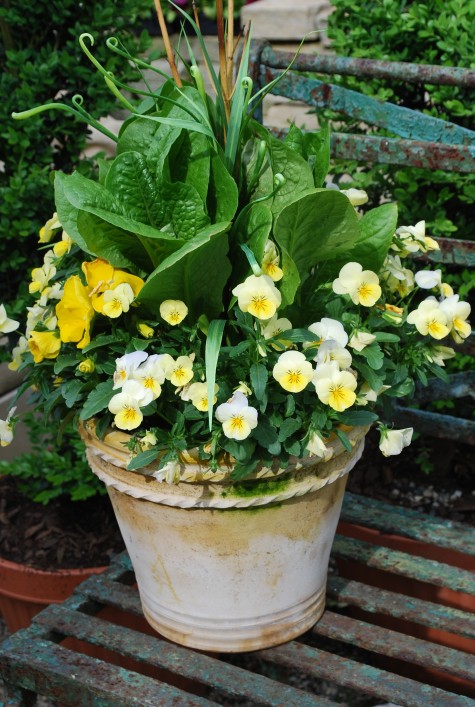 The lettuce pots are beautiful right now. I know this will sound hopelessly archaic, but I eat iceberg lettuce and tuna every day at lunch. Any lettuce, any mesclun roadside weed lettuce mix-a treat. The water that endows all the lettuces-I especially enjoy that which is crunchy and juicy. Spring-eminently juicy. Spring flowering plants are a treat to all of us who are winter weary. Thus lettuce figures prominently in my spring container design work. Juicy and fresh-lettuce is just about the best thing spring has to offer.
The lettuce pots are beautiful right now. I know this will sound hopelessly archaic, but I eat iceberg lettuce and tuna every day at lunch. Any lettuce, any mesclun roadside weed lettuce mix-a treat. The water that endows all the lettuces-I especially enjoy that which is crunchy and juicy. Spring-eminently juicy. Spring flowering plants are a treat to all of us who are winter weary. Thus lettuce figures prominently in my spring container design work. Juicy and fresh-lettuce is just about the best thing spring has to offer.
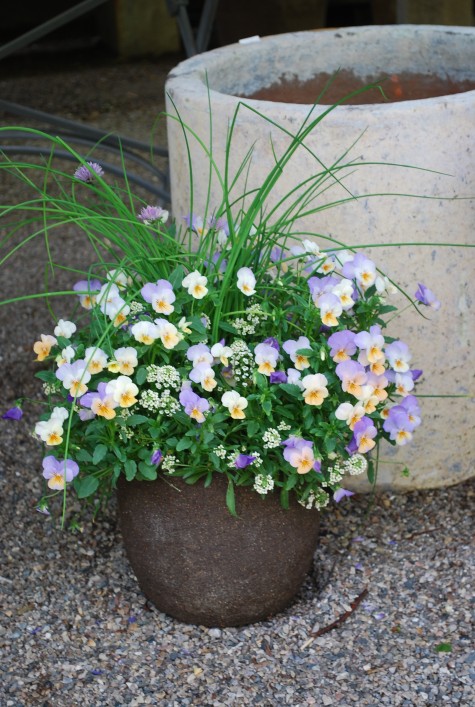 I like telling time by what is in bloom. I have no need for an armillary, or a watch. I have grown and tended many perennials-what I like about them the best is how they represent the season. In spring- the hellebores, phlox divaricata, epimediums, European ginger, Solomon’s Seal-the simple violets. Harbingers of the spring season.
I like telling time by what is in bloom. I have no need for an armillary, or a watch. I have grown and tended many perennials-what I like about them the best is how they represent the season. In spring- the hellebores, phlox divaricata, epimediums, European ginger, Solomon’s Seal-the simple violets. Harbingers of the spring season.
 I apologize-the light at 7am is dim, and I thought I could skip hauling the tripod outside. Though this photograph is not the sharpest, the idea is clear. These tall thin long tom clay pots are home to burgeoning spring violas-delightful. Spring like.
I apologize-the light at 7am is dim, and I thought I could skip hauling the tripod outside. Though this photograph is not the sharpest, the idea is clear. These tall thin long tom clay pots are home to burgeoning spring violas-delightful. Spring like.
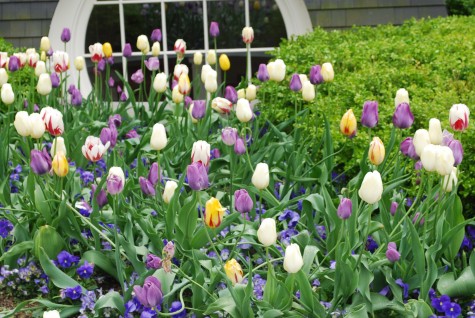 Spring in Michigan is short and sweet. Very sweet. The tulips-what could be better? This tulip mix-so celebratory of spring. Though I am racing miles ahead of the late spring season to design for summer, I so treasure our spring season.
Spring in Michigan is short and sweet. Very sweet. The tulips-what could be better? This tulip mix-so celebratory of spring. Though I am racing miles ahead of the late spring season to design for summer, I so treasure our spring season.
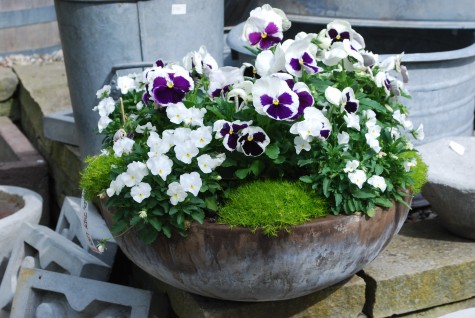
This pot-a strong arrangement of purple faced pansies, white violas and scotch moss in a very beautiful low bowl-this kind of spring statement sustains me.
Carter
 The saga of the rebuilding of my fountain begins and ends with Carter. The man with that short scruff of a white beard, the navy shirt, vest, and cap-that’s Carter. A combination of considerable brains, even more experience, patience and exacting craftsmanship-he and his crew have been my pleasure to observe for the last three days. They tore my leaking fountain apart, and rebuilt its foundation some three weeks ago. The stone for the coping had not been delivered two days when he picked it up; time to finish.
The saga of the rebuilding of my fountain begins and ends with Carter. The man with that short scruff of a white beard, the navy shirt, vest, and cap-that’s Carter. A combination of considerable brains, even more experience, patience and exacting craftsmanship-he and his crew have been my pleasure to observe for the last three days. They tore my leaking fountain apart, and rebuilt its foundation some three weeks ago. The stone for the coping had not been delivered two days when he picked it up; time to finish.
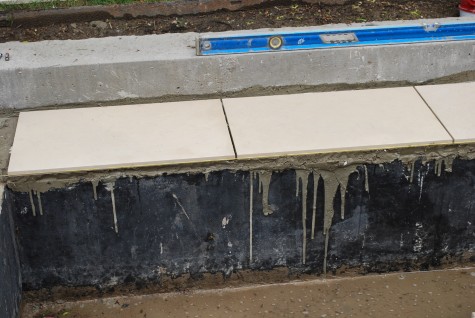 For pools and fountain stone, I specify a stone native to and quarried in Wisconsin. This particular limestone is dense, and has few pores. Indiana limestone is so porous, that pool copings and decks absorb too much water-a perfect medium for moss and algae. Though I would as soon look at moss as anything nature provides, I do not want to walk on it around a pool-too slippery. This stone is as dense and smooth surfaced as marble-and weathers my climate without a problem.
For pools and fountain stone, I specify a stone native to and quarried in Wisconsin. This particular limestone is dense, and has few pores. Indiana limestone is so porous, that pool copings and decks absorb too much water-a perfect medium for moss and algae. Though I would as soon look at moss as anything nature provides, I do not want to walk on it around a pool-too slippery. This stone is as dense and smooth surfaced as marble-and weathers my climate without a problem.
 Buck did CAD-computer assisted design-drawings for the quarry-each piece was cut to his exact specification and dimension. Communication is the art of life, a client once told me. I could tell Carter thought it was very cool that he did not need to cut or otherwise modify any piece of stone. I do not think I have ever seen a crew of four measure and remeasure like Carter’s group did; when a piece of stone was laid, it was laid in the right spot.
Buck did CAD-computer assisted design-drawings for the quarry-each piece was cut to his exact specification and dimension. Communication is the art of life, a client once told me. I could tell Carter thought it was very cool that he did not need to cut or otherwise modify any piece of stone. I do not think I have ever seen a crew of four measure and remeasure like Carter’s group did; when a piece of stone was laid, it was laid in the right spot.
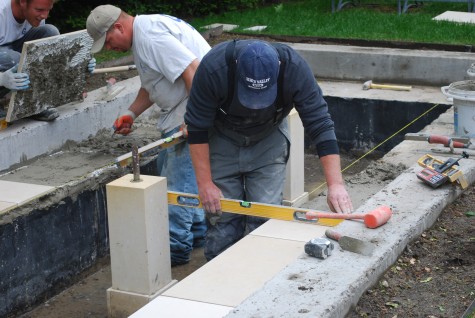 Each slab needed to be set in precisely the right location. OK, once located, each slab needed to be set exactly level. Watching Carter level a piece of stone is exactly like watching paint dry. Each piece took an incredibly long time. My eyes were crossing, and I thought I might black out-watching him tinker and tap.
Each slab needed to be set in precisely the right location. OK, once located, each slab needed to be set exactly level. Watching Carter level a piece of stone is exactly like watching paint dry. Each piece took an incredibly long time. My eyes were crossing, and I thought I might black out-watching him tinker and tap.
 He has a tool-a gizmo-that helps him determine if a slab is set level. The laser level-I could tell by looking at its battered casing that he uses it non stop. But make no mistake-I could see him using, and trusting his eye. I am very interested in the history and practice of fine craftsmanship. I have been watching the real deal, in my own back yard, for three solid days.
He has a tool-a gizmo-that helps him determine if a slab is set level. The laser level-I could tell by looking at its battered casing that he uses it non stop. But make no mistake-I could see him using, and trusting his eye. I am very interested in the history and practice of fine craftsmanship. I have been watching the real deal, in my own back yard, for three solid days.
The Wisconsin limestone is so dense, Carter directed that each piece be buttered with thinset mortar before he placed it in the mortar bed. The mortar bed was levelled and relevelled. Think of the foundation, and finish stone as a cookie-the thinset, and the bulk mortar-the creme filling. Unlike a sandwich cookie, the filling needs to grip both the foundation and the stone, and stay stubbornly stable in spite of stresses from up above, and underneath.
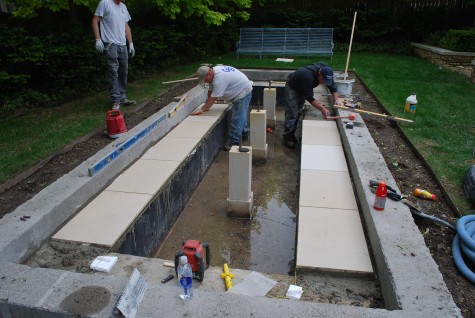 A client remarked recently that small spaces need to be designed just so-there is little margin for error. Any mistake in the layout or execution is all the more obvious in a small space. I did have occasion once to deal with a pool that had been dug, and shot with gunite-out of square. Needless to say, the pool coping stone, and its pattern had to be modified. Luckily, the pool terrace stone could be modified and recut in such a way that makes this mistake almost imperceptible.
A client remarked recently that small spaces need to be designed just so-there is little margin for error. Any mistake in the layout or execution is all the more obvious in a small space. I did have occasion once to deal with a pool that had been dug, and shot with gunite-out of square. Needless to say, the pool coping stone, and its pattern had to be modified. Luckily, the pool terrace stone could be modified and recut in such a way that makes this mistake almost imperceptible.
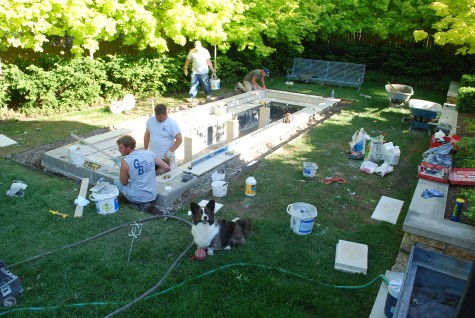
We had quite the event going on. I larned quite a bit about the technology and properties of concrete and mortar-not to mention the science of making something lay flat, and stick tight, for good.
Last night at 7 they finished the last of the mortaring of all the stone joints. I will need to wait 5 or 6 days before I can repaint the pool interior; all the work needs time to cure. I should have running water in no time.
Wirework Planters
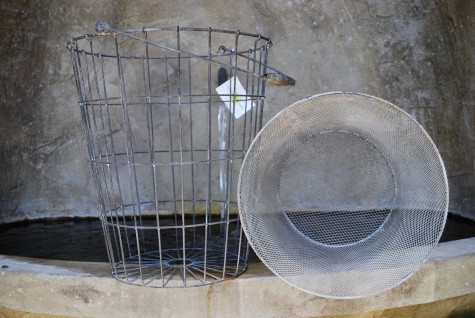 This photograph of a wirework planter and insert lowers my blood pressure considerably. I am planting furiously-directing and following three crews. My group-there are 16 of us. I know there are celebrated CEO’s who manage many more than I-but I find what I can keep track of, instruct and help out-16 is a plenty big number. I do plant pots for the store-it is recreation of a sort. I planted a few wirework planters yesterday; I have a big love for steel in any dimension. Steel wire, galvanized, painted, raw, faux finished- I find all the available forms of interest. Wire planters need lining-soil and wire need an intervening medium of some type.
This photograph of a wirework planter and insert lowers my blood pressure considerably. I am planting furiously-directing and following three crews. My group-there are 16 of us. I know there are celebrated CEO’s who manage many more than I-but I find what I can keep track of, instruct and help out-16 is a plenty big number. I do plant pots for the store-it is recreation of a sort. I planted a few wirework planters yesterday; I have a big love for steel in any dimension. Steel wire, galvanized, painted, raw, faux finished- I find all the available forms of interest. Wire planters need lining-soil and wire need an intervening medium of some type.
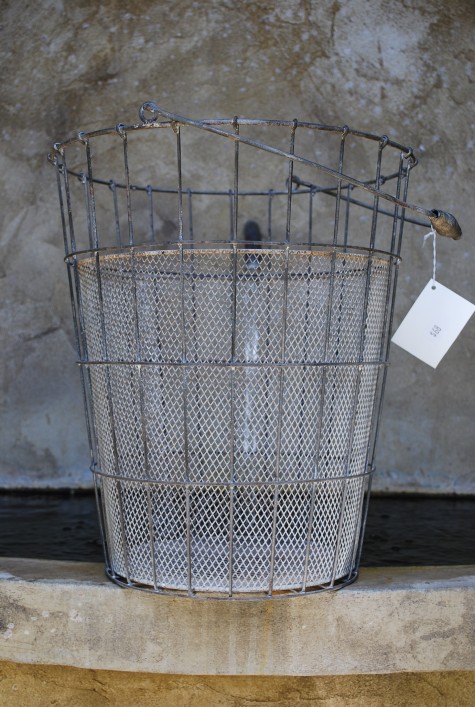 This galvanized steel basket came with a densely constructed liner. Landscape fabric is all this bucket needs to keep the soil where it belongs. The galvanized mesh is almost dense enough on its own to hold soil. The fabric will not obstruct the pattern of the diamond mesh in any way. This basket could be planted in a loose, or very contemporary manner, but surely it asks for a very simple liner.
This galvanized steel basket came with a densely constructed liner. Landscape fabric is all this bucket needs to keep the soil where it belongs. The galvanized mesh is almost dense enough on its own to hold soil. The fabric will not obstruct the pattern of the diamond mesh in any way. This basket could be planted in a loose, or very contemporary manner, but surely it asks for a very simple liner.
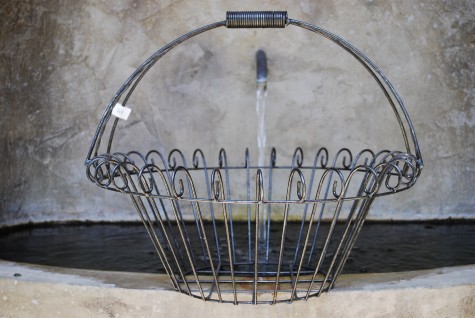 This round heavy wire basket-beautiful in its own right. To ready this basket for planting-any number of materials would work. Florist’s moss, in giant sheets, is a good choice. We call high quality florist’s moss “hides”- large intact sheets make easy work of lining wire. Small pieces are a nuisance to handle, in addition to being an invitation to topiary erosion. Wet soil running out the side of your basket-not so pretty. If you must use smaller moss pieces, overlap them a good amount. Well done moss makes a great presentation. The moss in contrast to the steel wire-easy on the eye. Alternative liners for wire baskets-you have choices., should florist’s moss not enchant you. The wiry coir mat-difficult to form, but eminently effective. Landscape fabric-cool and easy.
This round heavy wire basket-beautiful in its own right. To ready this basket for planting-any number of materials would work. Florist’s moss, in giant sheets, is a good choice. We call high quality florist’s moss “hides”- large intact sheets make easy work of lining wire. Small pieces are a nuisance to handle, in addition to being an invitation to topiary erosion. Wet soil running out the side of your basket-not so pretty. If you must use smaller moss pieces, overlap them a good amount. Well done moss makes a great presentation. The moss in contrast to the steel wire-easy on the eye. Alternative liners for wire baskets-you have choices., should florist’s moss not enchant you. The wiry coir mat-difficult to form, but eminently effective. Landscape fabric-cool and easy.
 This small handmade laser cut steel pot is lined in grey landscape fabric. This is a compatible pairing; the intricate steel work is the star of the show. The wiry succulent completes the thought.
This small handmade laser cut steel pot is lined in grey landscape fabric. This is a compatible pairing; the intricate steel work is the star of the show. The wiry succulent completes the thought.

Coir is thick and difficult to handle-these wire baskets came with the liner already made. The color and texture is a good contrast to the wirework. Containers such as these are perfect for herbs, as they drain fast. Succulents are likewise a good choice. A small basket such as this may not be a good choice for those flowers needing regular moisture. I will water once a day if I have to, but I like an every other day schedule the best. As this suits my life, I plant large containers.
 This fancy Nancy white wirework oval planter-I could line and plant this at least ten different ways. Should you be shopping, be clear in your own mind about what effect you are trying to achieve. Something delicate like the wire-I would go there first. Maidenhair ferns? Miniature fuchsias? Thyme, variegated oregano, and alyssum?
This fancy Nancy white wirework oval planter-I could line and plant this at least ten different ways. Should you be shopping, be clear in your own mind about what effect you are trying to achieve. Something delicate like the wire-I would go there first. Maidenhair ferns? Miniature fuchsias? Thyme, variegated oregano, and alyssum?
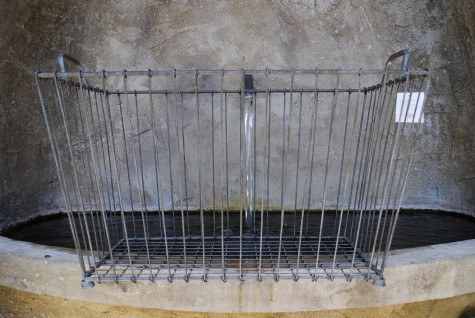 This geometric wire rectangle has plenty of space between the bars-so a bulkier liner material would work just fine.
This geometric wire rectangle has plenty of space between the bars-so a bulkier liner material would work just fine.
Natural materials from jute, burlap, hemp fiber and the like make great liner material. They have great textural appeal, which looks great paired with a simple container. Once you pass by the moss option, there are plenty of things out there. Fabrics-just that option alone could produce some stunning containers.
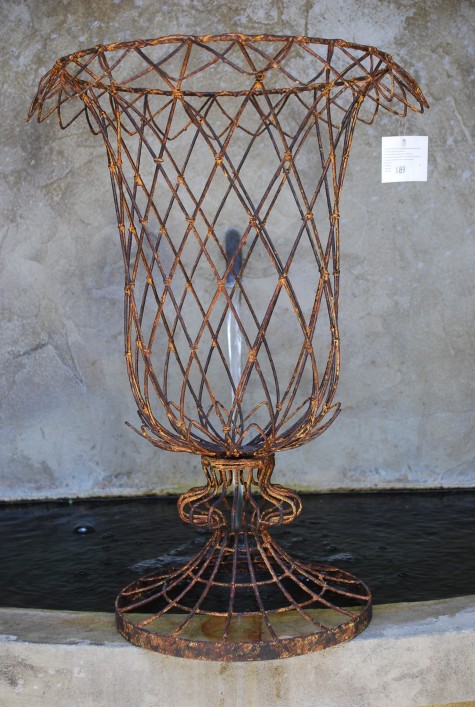
This faux finished wire urn is tall and elegant. I stuffed the entire thing with moss. The base-stuffed solid with moss.
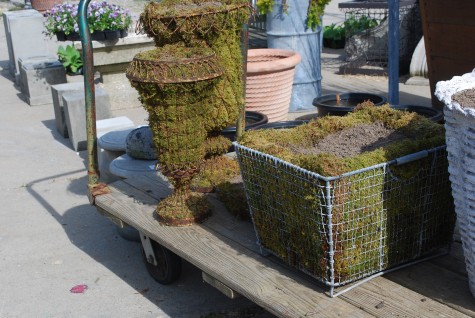
Once the moss is in place, I trim off the wild hairs, and dye it with moss dye. This helps a lot to keep the color better longer.
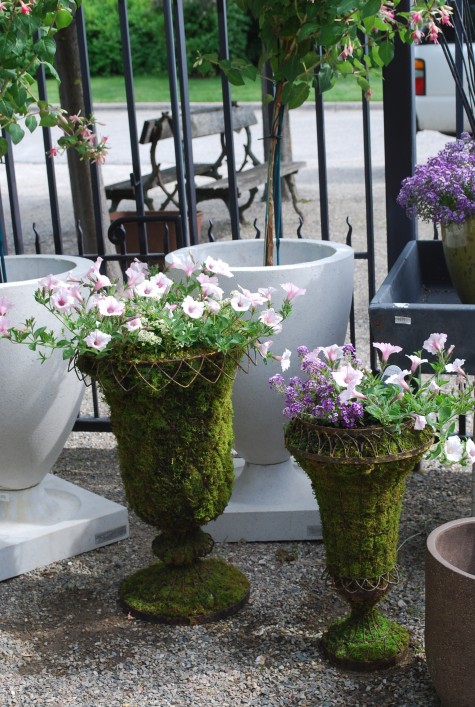
Twenty minutes this morning planting was the emotional equivalent of a cat nap. These vista silverberry mini petunias have a delightfully horizontal growth habit-very pretty.
